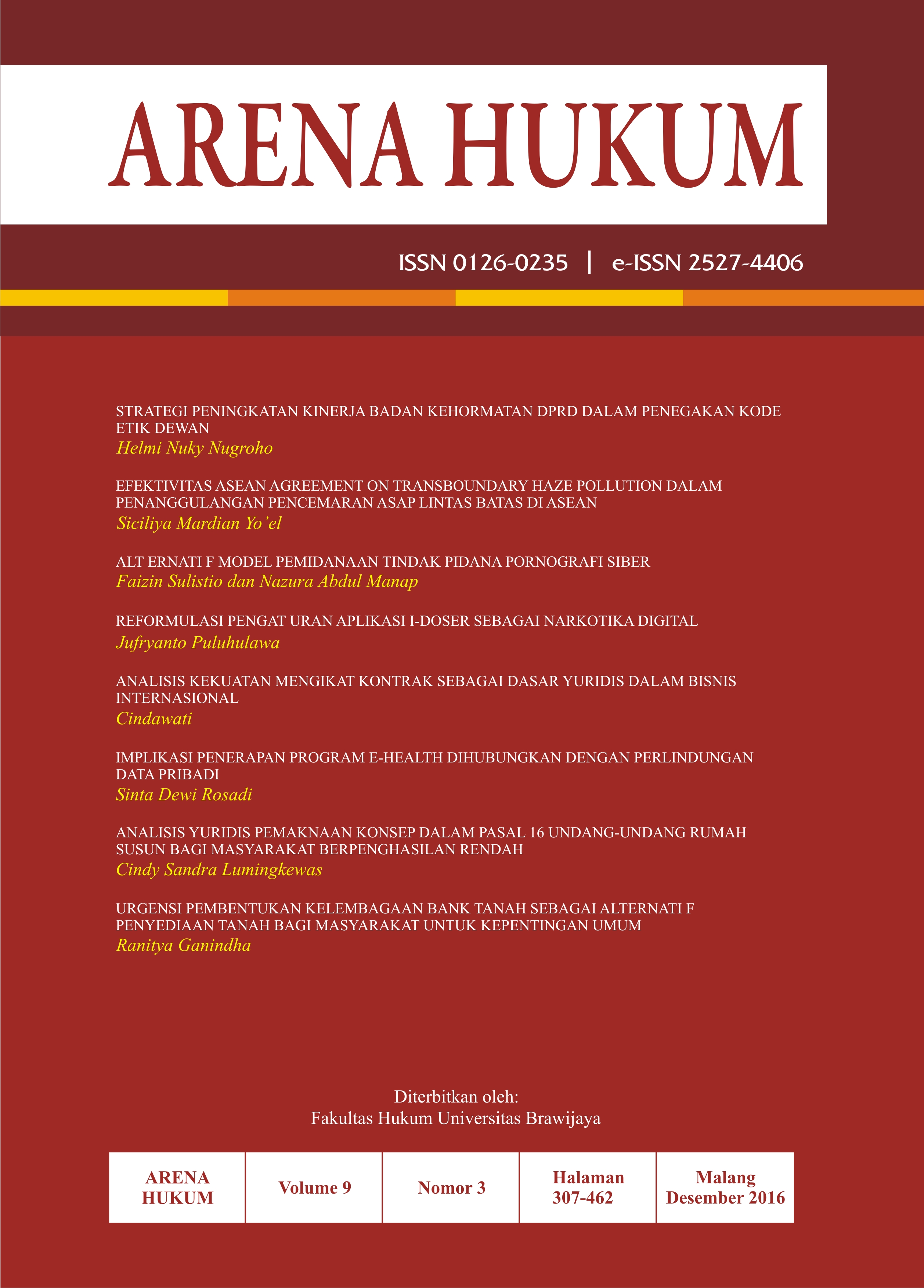ANALISIS YURIDIS PEMAKNAAN KONSEP DALAM PASAL 16 UNDANG-UNDANG RUMAH SUSUN BAGI MASYARAKAT BERPENGHASILAN RENDAH
DOI:
https://doi.org/10.21776/ub.arenahukum.2016.00903.7Keywords:
RusunAbstract
Abstract
The purpose of this research is to determine the concept of Article 16(2) of Apartment Act in favor of the LIC in terms of ownership of an apartment unit, and also the elaboration of this concept that provide convenience to the LIC. This is a normative legal research using the legislation and conceptual approach. The results is that the meaning of the concept of 20% in the provisions of Article 16(2) of the Apartment Act was the construction of general apartment at least 20% of the total floor area of commercial apartment is a legal obligation of the perpetrator development of this commercial, in which the liability asserted in Article 97 followed the criminal sanctions under Article 109. 20% should be interpreted according to the political law and balanced composition between the number of simple, medium and luxury homes (3: 2: 1). More detailed settings of Article 16(2) of Apartment Act are necessary because it takes certain assertions, among others: a. Executive Agency affirmation by government formation, incentives given to construction of general apartment actors, and to provide support and services to the ownership of the apartment unit for the LIC ; b. affirmation of the maximum limit for the commencement and completion of construction of general apartment as the implementation of the obligations of Article 16 (2); and, c. LIC classification affirmation made by Government Regulation.
Abstrak
    Tujuan penelitian ini adalah untuk mengetahui  dan menganalisis makna konsep pasal 16 ayat (2) UU Rumah Susun tentang kewajiban menyediakan rumah susun umum sekurang-kurangnya 20% (duapuluh persen) dari total luas lantai rumah susun komersial, dan bagaimana penjabaran konsep pasal 16 (2) UU Rumah Susun yang memberi kemudahan bagi MBR.Penelitian hukum normatif ini dengan menggunakan pendekatan peraturan perundang-undangan dan pendekatan konseptual. Hasil penelitiannya adalah bahwa makna konsep 20% dari ketentuan Pasal 16 ayat (2) UU Rumah Susun yaitu pembangunan rumah susun umum sekurangnya-kurangnya 20% dari total luas lantai rumah susun komersial yang dibangun merupakan kewajiban hukum dari pelaku pembangunan rumah susun komersial, di mana kewajiban ini dipertegas dalam Pasal 97 yang diikuti ancaman pidana dalam Pasal 109 Pengertian 20% itu seharusnya ditafsirkan menurut politik hukum tentang komposisi jumlah rumah yang berimbang antara rumah rumah sederhana, rumah menengah, dan rumah mewah (3 : 2 : 1). Penjabaran konsep pasal 16 ayat (2) Undang-Undang Rumah Susun diperlukan karena dibutuhkan penegasan-penegasan tertentu, antara lain: a. penegasan pembentukan Badan Pelaksana oleh pemerintah, pemberian insentif kepada pelaku pembangunan rumah susun serta memberikan bantuan dan kemudahan untuk pemilikan sarusun bagi MBR; b. penegasan tentang jangka waktu dan selesainya pembangunan rumah susun umum sebagai pelaksanaan kewajiban dari Pasal 16 ayat (2) Undang-Undang Rumah Susun; dan, c. penegasan klasifikasi MBR dilakukan melalui Peraturan Pemerintah.
References
Buku
Algra, N.E. dan K. van Duyvendijk. Mula Hukum. Terjemahan J.C.T. Simorangkir dari Rechtsaanvang. Jakarta: Binacipta, 1983.
Komisi Yudisial Republik Indonesia. Bahan Bacaan Klinik Etik dan Hukum, Buku I Materi Hukum. Jakarta: Komisi Yudisial, 2015.
Koeswahyono, Imam. Hukum Rumah Susun. Suatu Bekal Pengantar Pemahaman. Malang: Bayumedia Publishing, 2004.
Marzuki, Peter Mahmud. Penelitian Hukum. Jakarta: Prenada Media Group, 2011.
Muliadi, Ahmad. Politik Hukum. Cetakan Ke-2. Padang: Akademia Permata, 2014.
Murphy, Jeffrie G. dan Jules L. Coleman. Philosophy of Law. An Introduction to Jurisprudence. Atlanta: Westview Press, Inc., 1990.
Rasjidi, Lili. Dasar-dasar Filsafat Hukum. Bandung: Alumni, 1982.
Rawls, John. Teori Keadilan. Terjemahan Uzair Fauzan dan Heru Prasetyo dari A Theory of Justice. Yogyakarta: Pustaka Pelajar, 2006.
Santoso, Urip. Hukum Perumahan. Jakarta: Kencana Prenadamedia Group, 2014.
Peraturan Perundang-undangan
Undang-undang Nomor 16 Tahun 1985 tentang Rumah Susun.
Undang-undang Nomor 12 Tahun 2011 tentang Pembentukan Peraturan Perundang-undangan.
Undang-undang Nomor 20 Tahun 2011 tentang Rumah Susun.
Peraturan Pemerintah Nomor 4 Tahun 1988 tentang Rumah Susun.
Peraturan Pemerintah Nomor 88 Tahun 2014 tentang Pembinaan Penyelenggaraan Perumahan dan Kawasan Permukiman.
Peraturan Menteri Perumahan Rakyat Nomor 10 Tahun 2012 tentang Penyelenggaraan Perumahan dan Kawasan Pemukiman Dengan Hunian Berimbang.
Peraturan Menteri Perumahan Rakyat Republik Indonesia Nomor 3 Tahun 2014 tentang Fasilitas Likuiditas Pembiayaan Perumahan Dalam Rangka Pengadaan Perumahan Melalui Kredit/Pembiayaan Pemilikan Rumah Sejahtera.
Naskah Internet
Bentham, Jeremy. “An Introduction to the Principles of Morals and Legislationâ€. http://oll.libertyfund.org/titles/278. Diakses 29 Oktober 2015.
Kementerian Pekerjaan Umum dan Perumahan Rakyat. “Pemda Harus Punya Data Jumlah MBR Yang Perlu Bantuan Pembiayaan Perumahanâ€. http://www.pu.go.id/berita/10622/Pemda-Harus-Punya-Data-Jumlah-MBR-Yang-Perlu-Bantuan-Pembiayaan-Perumahan. Diakses 14 Mei 2016.
Downloads
Published
How to Cite
Issue
Section
License
Copyright (c) 2017 Cindy Sandra Lumingkewas

This work is licensed under a Creative Commons Attribution-NonCommercial 4.0 International License.
This journal embed or display simple machine-readable CC licensing information. This journal allow reuse and remixing of content in accordance with a Creative Commons license, Creative Commons Attribution-NonCommercial 4.0 International License (CC BY NC). This license (CC BY NC) allows other users to re-edit / rewrite and rebuild a work non-commercially as long as the user gives credit and licenses his new work in the same domain.
Authors who publish with this journal agree to the following terms:
- Authors retain copyright and grant the journal right of first publication with the work simultaneously licensed under a Creative Creative Commons Attribution-NonCommercial 4.0 International License (CC BY NC) that allows others to share the work with an acknowledgement of the work's authorship and initial publication in this journal.
- Authors are able to enter into separate, additional contractual arrangements for the non-exclusive distribution of the journal's published version of the work (e.g., post it to an institutional repository or publish it in a book), with an acknowledgement of its initial publication in this journal.
- Authors are permitted and encouraged to post their work online (e.g., in institutional repositories or on their website) prior to and during the submission process, as it can lead to productive exchanges, as well as earlier and greater citation of published work (See The Effect of Open Access).
















